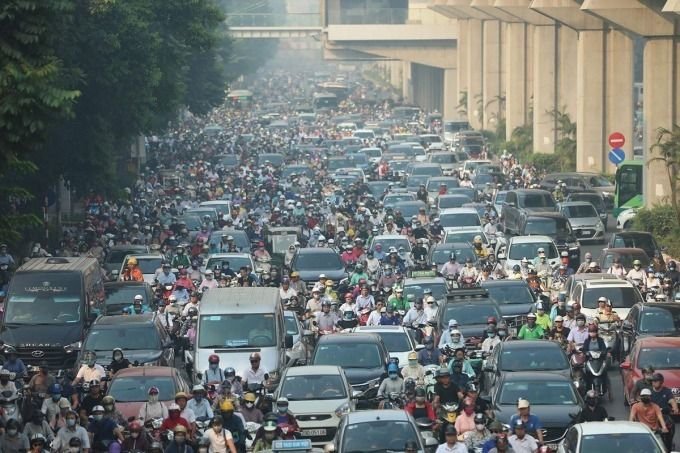
Proposal to ban motorbikes from beltway 3 3
The Hanoi People’s Committee has just sent to the People’s Council at the same level a report on the target program to reduce congestion and ensure traffic safety for the period 2021 – 2025. Accordingly, in the coming years, the city will continue to research and perfect procedures.
The draft project for zoning restrictions on motorbikes is being developed by the Hanoi Department of Transport, with the consulting unit being the Institute of Transport Strategy and Development.
The pilot area is limited by the belt of 3 bridges Thanh Tri – Phap Van – Nguyen Xien – Pham Hung – Pham Van Dong – Thang Long bridge – Hoang Sa – Truong Sa – Nguyen Van Linh (extended National Highway 5) – node
Congestion on Nguyen Trai Street in May 2020.
According to the draft project, to ban motorbikes in the central areas, the city will complete the traffic infrastructure including urban belts and trunk roads with a length of about 142 km, converting the use of 4 stations.
In the period 2026 – 2030, the city will operate two urban railway lines: Cat Linh – Ha Dong and Nhon – Hanoi station;
Public transportation in this period is expected to cover over 30% of people’s travel needs;
After 2030, the city will learn from experience and gradually expand the scope of restricting motorbike operations from belt 4 in combination with main trunk routes;
The draft project states that Hanoi will continue to invest in urban transport infrastructure, bus stations, and static parking lots, and at the same time put into operation two more urban railway lines, line 3, Hanoi station section.
Along with that, the city arranges other means of transportation such as public bicycles with 10,000 bicycles and 15-20 minibus routes.
The consulting unit estimates that public transportation in the period after 2030 will take care of about 45-50% of people’s travel needs, transport capacity can meet over 80% of trips in limited areas.
When entering the restricted area, people park their personal vehicles at transit parking lots and switch to other types of transportation.
The city will renovate sidewalks and roadways for pedestrians to access the public transportation system;
Hanoi will also support the purchase of used motorbikes and eliminate motorbikes that do not meet environmental standards.
According to calculations in the draft project, the city needs to invest about 334,670 billion VND from the budget and socialized investment sources for the motorbike restriction plan, mainly to invest in infrastructure and traffic development.
The policy of restricting motorbikes in Hanoi is expected to affect about 3.5 to 6.5 million urban residents from time to time, causing them to change their travel and living habits.
As of December 2020, Hanoi had 7.1 million vehicles, including 6.1 million motorbikes, 167,000 electric motorbikes and 869,000 cars.
Many traffic experts believe that banning motorbikes after 2025 will be difficult to implement because the public transportation system cannot meet people’s needs.
Doan Loan





